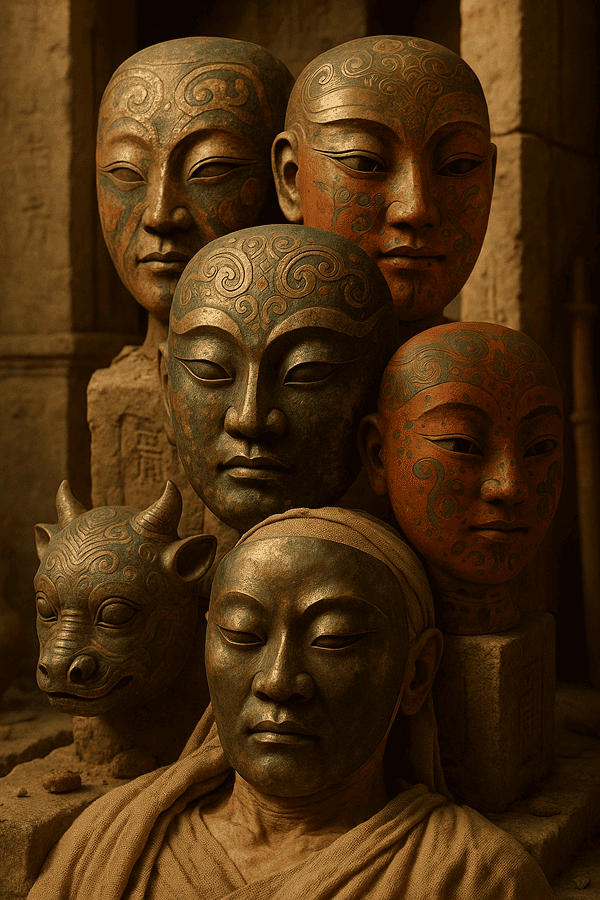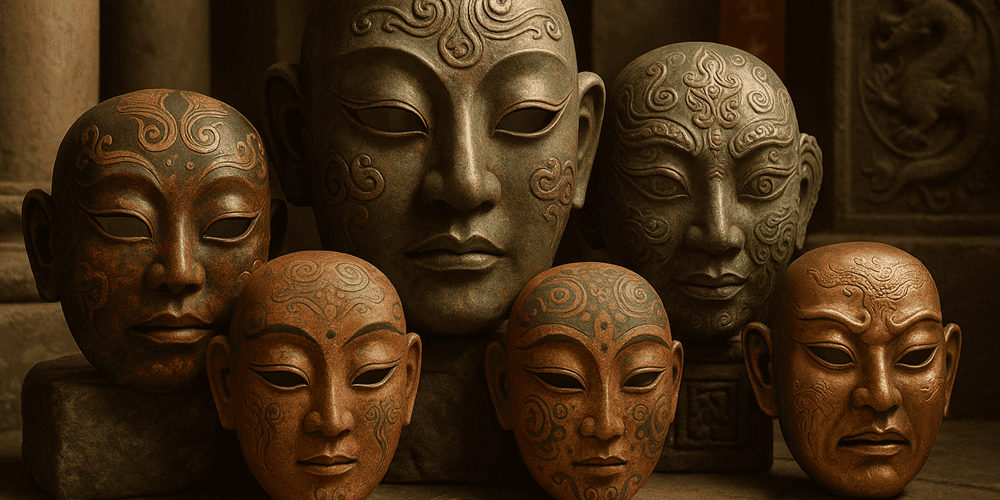Han Dynasty Masks are among the most fascinating and significant artifacts from ancient China, reflecting the complex social, religious, and artistic life of the Han Dynasty (206 BCE – 220 CE). These masks are known for their distinctive features: prominent cheekbones, stylized eyes, expressive mouths, and intricate decorative elements. Crafted from bronze, clay, lacquer, or wood, Han Dynasty Masks often exhibit a blend of realism and abstraction, making them both visually striking and symbolically rich. Belonging to the core of early Chinese civilization, these masks were produced across the Han Empire, which covered much of present-day China and became a formative period in the nation’s cultural history.
Historical Origins: The Evolution of Han Dynasty Masks
The origins of Han Dynasty Masks can be traced back to earlier Chinese civilizations such as the Shang and Zhou dynasties, but it was during the Han period that mask-making reached new heights of sophistication and diversity. The term “Han Dynasty Mask” refers specifically to masks created during this era, often for ritual, funerary, or theatrical purposes. The Han Dynasty was a time of great innovation and expansion, both territorially and culturally. Mask-making evolved to reflect religious beliefs, ancestor worship, and the aesthetics of the imperial court. Archaeological discoveries, including tomb finds and temple sites, have revealed a wide variety of masks used in burial rites, shamanic ceremonies, and court entertainments. Over time, the designs of Han Masks became more elaborate, incorporating influences from Central Asia and neighboring cultures, and setting the stage for later developments in Chinese mask traditions, such as Dragon Masks.
Cultural Significance and Symbolism: The Meaning of Han Dynasty Masks
Han Dynasty Masks carried profound cultural and spiritual significance. In funerary contexts, masks were believed to protect the deceased, ward off evil spirits, and ensure safe passage to the afterlife. Many masks depicted deities, animals, or mythical beings, symbolizing strength, protection, or transformation. Ritual masks were used by shamans and priests to communicate with spirits, perform exorcisms, or lead ceremonies that reinforced social order. The symbolism of these masks was closely tied to concepts of immortality, cosmic harmony, and the balance between humans and the supernatural. Myths, legends, and ancient texts often mention the power of masks to transform the wearer and connect them to divine forces, reflecting the deep integration of masks into Han religious and social life.
Materials and Craftsmanship: Creating Han Dynasty Masks
The craftsmanship of Han Dynasty Masks is notable for its diversity and technical skill. Artisans used bronze, clay, lacquer, wood, and sometimes precious stones or metals for inlays and decoration. The process typically involved molding, carving, and painting, with special attention given to symmetry and expressive detail. Bronze masks were often cast using the lost-wax method, while clay masks were shaped and fired in kilns. Some masks were covered with lacquer for a glossy, durable finish, while others were painted with mineral pigments in red, black, or gold. Decorative motifs included dragons, tigers, phoenixes, clouds, and geometric patterns, each carrying symbolic meaning. Regional differences in mask styles reflected local traditions, beliefs, and available materials, contributing to the rich variety of Han mask art.
Functions and Use: Ritual, Theatre, and Social Life
Han Dynasty Masks served a wide range of functions. In funerary practices, they were placed on the faces of the dead, symbolizing both protection and transformation. In religious and shamanic ceremonies, masks were worn by ritual specialists to channel spirits, conduct exorcisms, and perform dances that invoked blessings or averted misfortune. Some masks were used in early forms of Chinese theatre or court entertainment, helping to tell stories, represent characters, or create a sense of spectacle. Over time, as religious and social practices evolved, the use of Han Masks shifted from strictly sacred contexts to more public and performative settings. Today, Han Dynasty Masks continue to inspire modern artists and performers, and are featured in museum exhibitions and cultural festivals.
Regional Variations: Diversity Among Han Dynasty Masks
Han Dynasty Masks exhibit significant regional variation, reflecting the vast and diverse nature of the Han Empire. In northern China, masks were often larger and more robust, with bold features and intricate bronze work. Southern masks tended to be lighter, with more delicate carving and subtler decoration. Local traditions influenced mask shapes, colors, and motifs, resulting in a spectrum of styles across the empire. Some regions favored animal masks, while others preferred representations of ancestors or deities. When compared to other ancient mask traditions, Han Masks are distinguished by their blend of realism and stylization, as well as their integration into both religious and secular life. Parallels can be drawn with other Asian masks, but Han Dynasty Masks remain uniquely Chinese in their artistic and symbolic language.

Famous Examples and Collections: Where to See Han Dynasty Masks
Many of the most significant Han Dynasty Masks have been unearthed in archaeological excavations, particularly in tombs of nobles and high-ranking officials. These masks are now displayed in major museums such as the National Museum of China (Beijing), the Shanghai Museum, and the Shaanxi History Museum. Notable finds include bronze death masks, lacquered ritual masks, and clay masks adorned with precious stones. Private collectors and academic institutions also house important examples, many of which are included in traveling exhibitions. For those interested in exploring or collecting Han Dynasty Masks, online galleries and educational platforms like toddmasks.com offer curated selections and detailed information.
Influence on Art and Culture: The Legacy of Han Dynasty Masks
Han Dynasty Masks have left a profound mark on Chinese art, theatre, and material culture. Their forms and motifs have influenced later mask traditions, including those used in Chinese opera, folk festivals, and martial arts. Han Masks appear in literature, visual arts, and contemporary design, where their striking appearance continues to inspire creativity and innovation. Their role in religious and social rituals has been explored in academic research, documentaries, and museum exhibitions. In modern times, the imagery of Han Dynasty Masks is often referenced in fashion, graphic design, and popular media, serving as a symbol of China’s rich artistic heritage. The connection between Han masks and later traditions, such as Dragon Masks, highlights the enduring influence of these ancient artifacts.
Modern Status and Preservation: Han Dynasty Mask Traditions Today
The preservation of Han Dynasty Masks and their traditions is supported by museums, universities, and cultural heritage organizations. Master artisans, scholars, and curators work to document, restore, and replicate ancient masks, ensuring that their techniques and symbolism are not lost to time. Educational programs, workshops, and exhibitions foster public appreciation and encourage new generations to engage with the art of mask-making. Modern adaptations incorporate contemporary materials and artistic approaches, but the core values of craftsmanship, symbolism, and cultural continuity remain central. International interest in Han Dynasty Masks continues to grow, with collectors and researchers seeking to understand their historical and artistic significance.
Collecting and Acquisition: The Market for Han Dynasty Masks
The market for Han Dynasty Masks is specialized and often focused on museums, academic institutions, and serious collectors. Authentic masks are rare and highly valued, with prices reflecting their age, provenance, craftsmanship, and historical importance. Legal and ethical considerations are paramount, as many masks are protected cultural artifacts and should only be acquired with proper documentation and respect for heritage laws. Reproduction masks and scholarly replicas are also available for educational and decorative purposes. Online platforms like toddmasks.com provide guidance on identifying authentic Han Dynasty Masks and emphasize the importance of ethical collecting practices.
